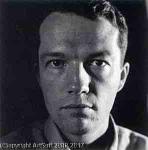George Brecht
George Brecht
Place: New York
Born: 1926
Death: 2008
Biography:
George Brecht and is widely seen as an important precursor to conceptual art. He described his own art as a way of “ensuring that the details of everyday life, the random constellations of objects that surround us, stop going unnoticed.”
Brecht was born George Ellis MacDiarmid in New York, August 27, 1926. His father, also George Ellis MacDiarmid, was a professional flautist who had toured with John Philip Sousa's marching band before settling in New York to play bass flute for the Metropolitan Opera Orchestra and the NBC Symphony Orchestra. After his father's death from alcoholism when Brecht was 10 years old, he moved with his mother to Atlantic City, New Jersey. He enlisted for military service in 1943, and it was whilst he was stationed near the Black Forest, Germany, 1945, that he changed his surname to 'Brecht' - 'not in reference to Bertolt Brecht, but because he liked the sound of the name'.
After World War II, he studied chemistry at the Philadelphia College of Pharmacy & Science, finishing his degree and marrying his first wife Marceline in 1951. After working briefly for Charles Pfizer & Co as a quality control inspector, he took a job as a research chemist for Johnson & Johnson in 1953, settling in New Jersey. Over the next decade he would register 5 US patents and 2 co-patents including four patents for tampons. His only son Eric was born in New Jersey in 1953.
Whilst working as a chemist (a job that he would keep until 1965), Brecht became increasingly interested in art that explored chance. Initially influenced by Jackson Pollock, and Robert Rauschenberg - Rauschenberg's exhibition of grass seeds, Growing Painting, 1954, left 'a significant impression on him' - he began to formulate ideas about 'chance method schemes' that would eventually be printed as a booklet by the Something Else Press as Chance Imagery (1957/66). The work was 'a systematic investigation of the role of chance in the 20th century in the fields of science and avant-garde art... reveal his respect for Dadaist and surrealist projects as well as for the more complex aspects of the work of Marcel Duchamp, whom he considered the embodiment of the 'artist-researcher'. Artworks in this period included bed-sheets stained with ink he called Chance Paintings.
In 1957, Brecht sought out the artist Robert Watts, after seeing his work exhibited at Douglass College, Rutgers University, where Watts taught. This led to lunch meetings once a week for a number of years at a cafe between the university and Brecht's laboratory. Watts' colleague Allan Kaprow would also regularly attend these informal meetings. Discussions at these lunches would lead directly to the setting up of the Yam Festival, 1962–63, by Watts and Brecht, seen as one of the most important precursors to Fluxus. The meetings also led to both Brecht and Kaprow attending John Cage's class at The New School for Social Research, New York, often driving down together from New Brunswick.
Brecht studied with John Cage between 1958 and 1959, during which time he invented, and then refined, the Event Score which would become a central feature of Fluxus. Typically, Event Scores are simple instructions to complete everyday tasks which can be performed publicly, privately, or negatively (i.e., deciding not to perform them at all). These ideas would be taken up and expanded upon up by La Monte Young, Yoko Ono and many other avant-garde artists who passed through these classes. The two had originally met in 1957 when Brecht heard that Cage was planning to hunt mushrooms in the New Jersey area; he rang him up and invited him to 'stop by and say hello'. Cage accepted, and returned the invitation; it was whilst Brecht, Kaprow and their families were visiting his house in Stony Point on the Hudson, that Cage invited them to attend his classes in New York. Ironically, musicians found the course far harder than the visual artists who had enrolled;
"Cage... was very keenly a philosophical mind, not just an artist's mind; his sense of aesthetics was secondary and thought was primary. He impressed me immediately. So I thought, well, who cares if he's a musician and I'm a painter. This is unimportant. It's the mind that transcends any medium.....
More...
Wikipedia link: Click Here





